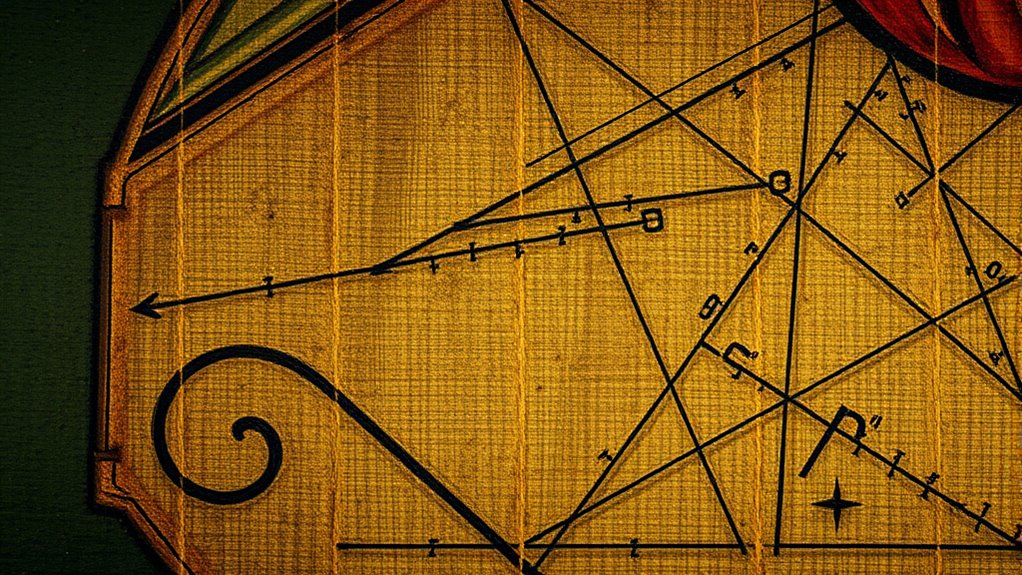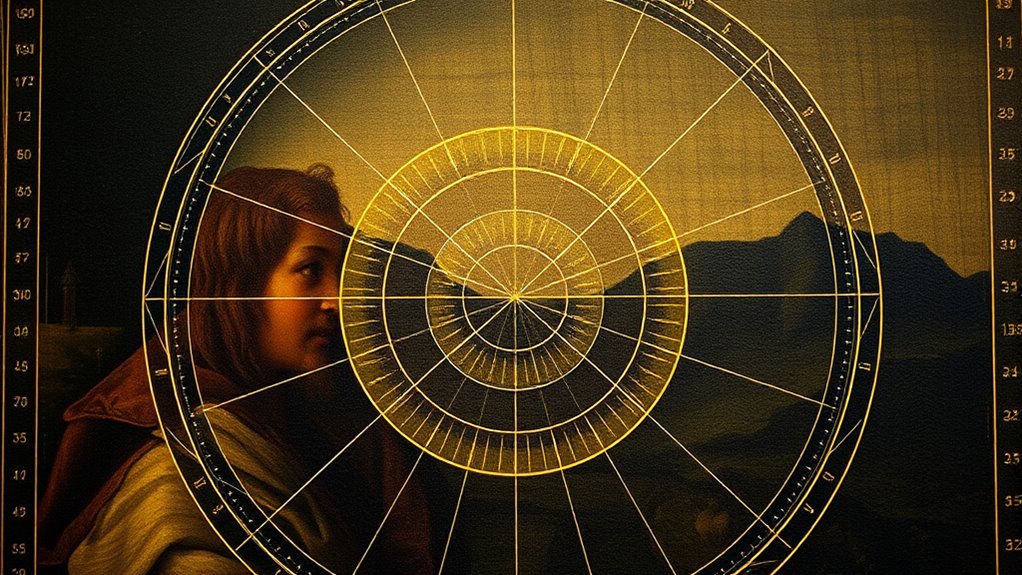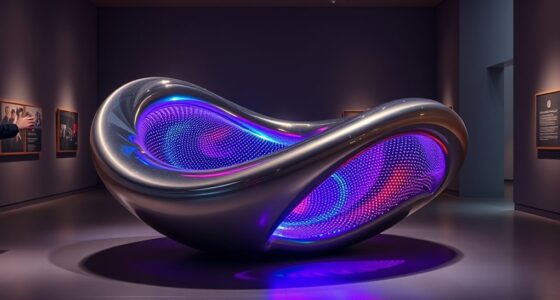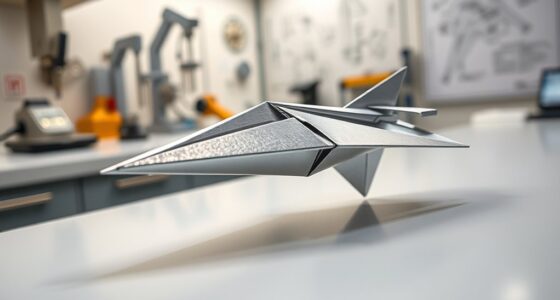In Renaissance masterpieces, artists deliberately used math principles like proportional grids and geometric ratios, such as the golden ratio, to create harmony and balance. These calculations guided figure placement, composition, and visual flow, making the artworks naturally pleasing to the eye. By applying these hidden mathematical rules, they achieved beauty that resonates subconsciously. If you continue exploring, you’ll uncover how these precise techniques shaped some of the world’s most iconic artworks.
Key Takeaways
- Renaissance artists used proportional grids based on geometric ratios like the golden ratio to plan compositions precisely.
- Mathematical analysis guided the placement and sizing of figures, enhancing visual harmony and balance.
- Geometric constructions and ratios ensured symmetry, natural flow, and dynamic movement within artworks.
- Artists studied mathematical harmony, embedding ratios that subconsciously attract viewers’ attention.
- The integration of math principles created aesthetically pleasing masterpieces that resonate on a subconscious level.

During the Renaissance, artists didn’t just rely on their creativity; they also employed sophisticated mathematical principles to create balanced and harmonious masterpieces. One key technique involved the use of proportional grids, which helped artists divide their compositions into precise sections, ensuring every element was in harmony with the whole. These grids weren’t random; they followed specific geometric ratios that dictated how different parts of a painting or sculpture related to each other. By applying proportional grids, artists maintained consistency in size and placement, making their work more pleasing to the eye. Furthermore, the use of mathematical tools like proportional grids allowed artists to plan complex compositions with remarkable accuracy. Additionally, understanding and applying these ratios required a deep knowledge of mathematical harmony, which artists like Leonardo da Vinci studied extensively. They often used mathematical analysis to determine the ideal placement of figures and objects within their works, ensuring perfect balance and proportion. The development of these techniques was also influenced by the era’s growing interest in the scientific method, which encouraged a more analytical approach to art and design. This scientific approach also led artists to explore geometric constructions to achieve precise symmetries and ratios in their work. You might not immediately notice these subtle calculations, but they’re fundamental to the overall aesthetic. Geometric ratios, like the golden ratio—approximately 1.618—appear repeatedly in Renaissance art. Artists intentionally used these ratios to determine the size of figures, the placement of key elements, and the spacing within their compositions. For instance, they might divide a canvas using the golden ratio, positioning focal points at specific points along these divisions. This creates a natural flow that guides your eye seamlessly across the artwork, making it feel both balanced and dynamic.
The use of proportional grids and geometric ratios wasn’t just about visual appeal; it also served to elevate the viewer’s experience. When you look at a Renaissance masterpiece, you’re subconsciously drawn to these harmonious relationships. The figures won’t seem awkward or out of place because they’re aligned according to these mathematical principles. Artists like Leonardo da Vinci studied these ratios extensively, often sketching out grids and diagrams to plan their compositions. They understood that math could enhance beauty, making their work resonate on a deeper, almost subconscious level.
Frequently Asked Questions
How Did Renaissance Artists Discover Mathematical Principles Independently?
You might wonder how Renaissance artists discovered mathematical principles independently. They relied on artistic intuition and geometric exploration, experimenting with proportions and perspectives. Through careful observation and trial, they uncovered ratios like the golden ratio, which enhanced their compositions. This intuitive approach allowed them to grasp underlying geometrical concepts, enabling them to create masterpieces with harmonious proportions without formal mathematical training.
Are There Hidden Mathematical Codes in Renaissance Sculptures?
You might wonder if Renaissance sculptures hide secrets through hidden symbols and artistic algorithms. Many experts believe artists embedded subtle mathematical codes within their works, like proportions and geometric patterns, to convey deeper meanings. These hidden symbols serve as artistic algorithms that reveal advanced knowledge of math and harmony. By analyzing these elements, you can uncover the mathematical language behind the artistry, adding a new layer of appreciation to these masterpieces.
Did Renaissance Painters Use Any Specific Mathematical Ratios Intentionally?
You might think Renaissance painters only relied on intuition, but they intentionally used specific mathematical ratios like the Golden Ratio for proportional design. This ratio helped create harmony and balance in their compositions, making their artwork more pleasing to the eye. By applying these precise proportions, they achieved a sense of natural beauty and perfection, demonstrating their deep understanding of mathematics as a tool for artistic mastery.
How Did Mathematics Influence the Choice of Colors in Renaissance Art?
You see, mathematics influenced how Renaissance artists chose colors through color theory and pigment mixing. They understood proportions and relationships between colors, helping them create harmony and depth in their work. By applying mathematical ratios, they mastered blending pigments for desired hues and tones. This scientific approach allowed them to achieve realistic shading and vibrant compositions, demonstrating how math played a vital role in their artistic choices and mastery of color.
Can Modern Technology Uncover More Mathematical Secrets in Renaissance Works?
Imagine uncovering secrets hidden in Renaissance art that even the artists didn’t realize they encoded. Modern technology, like AI and advanced imaging, can reveal more about artistic symbolism and cultural influences woven into these masterpieces. You might discover mathematical patterns that deepen your understanding of the era’s worldview, revealing how math shaped their creative choices. The possibilities are thrilling, hinting that these artworks still hold mysteries waiting for you to access.
Conclusion
As you step back and gaze at those masterpieces, you realize there’s more than meets the eye. The hidden mathematics woven into every brushstroke hints at secrets waiting to be uncovered. Could these ancient artists have understood the universe’s deepest patterns? The truth remains just beyond reach, tempting you to explore further. What other mysteries lie behind the timeless beauty of Renaissance art? The answer’s closer than you think—if you dare to look deeper.









